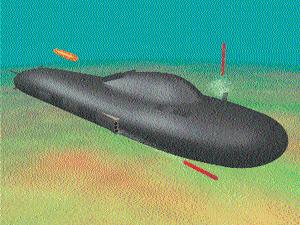



Future Attack Submarine
The Defense Science Board (DSB) task force on the “Submarine of the Future” in its July 1998 report called for pursuing a vigorous technology development program in preparation for a new and more capable successor to the Virginia class in the 2020s. Dismissing the suggestion for a force mix that includes diesel-electric submarines, the panel “firmly reaffirmed” that the Virginia-class follow-on should be a “large” nuclear ship offering high transit speed, independent logistics, and endurance – as well as the substantial internal volume necessary for unconventional payloads, such as auxiliary vehicles. Suggesting that “weapon-specific interfaces” such as torpedo and Vertical Launch System tubes be avoided, the group postulated “using ‘bomb bay’ techniques or other large aperture openings, coupled with external storage of rapid-response weapons.” In this concept, today’s torpedo room would be supplanted by a free-flooding weapons bay reconfigurable for a variety of weapon and offboard sensor payloads.
The task force recommended that the traditional emphasis on SSN propulsion and quieting be shifted to “connectivity, sensors, weapons, adjuvant vehicles, and interfaces with the water.” And finally, the panel suggested that DoD needs to broaden participation and reallocate taskings in the research, development, acquisition, and performance verification of new SSN designs. Thus, they recommended a “wide open look” at the future submarine by the Navy and the Defense Advanced Research Projects Agency (DARPA), with substantial industry input to the development of alternatives. Subsequently, DARPA and the Navy have signed a Memorandum of Agreement to study future fast-attack submarine design concepts, with a focus on advanced payloads and sensor systems.
The Navy and industry have concluded that electric drive will be a necessary, but not sufficient, condition for retaining stealth margins (i.e., standoff and counterdetection) into the far future. This assumes potential adversaries will possess sensor and processor technology in the 2015 timeframe, which is similar to that which the US is developing now. Furthermore, electric drive provides the opportunity to use all (rather than only about 15 percent) of the useful reactor power for a wide range of high power, high energy, and high endurance payloads, which the future will bring. Today, some 85 percent of the design reactor power can only be used for propulsion. Other benefits include the flexibility that electric drive brings to naval architecture (eliminate the tyranny of the shaft through external motors), on-the-fly reapportionment of power to deal with casualties, battle damage, or countermeasures (for high-speed incoming weapons), and technology growth potential in related technologies.
Specifications
|
| Builder |
|
| Power Plant |
|
| Length | feet
|
| Beam | feet
|
| Draft | feet
|
| Displacement |
tons
|
| Capacity |
|
| Speed | knots ( mph)
|
| Crew |
|
| Aircraft |
|
Ships
|
| Name |
Number |
Builder |
Homeport |
Ordered |
Commissioned |
Decommissioned |
|
|
|
|
|
|
|
|
| SSN-804 | | | 2015 | 2021 | |
| SSN-805 | | | 2015 | 2021 | |
| SSN-806 | | | 2015 | 2021 | |

Sources and Resources
http://www.fas.org/man/dod-101/sys/ship/fas.htm
Maintained by Robert Sherman
Originally created by John Pike
Updated Tuesday, October 26, 1999 1:48:14 PM





